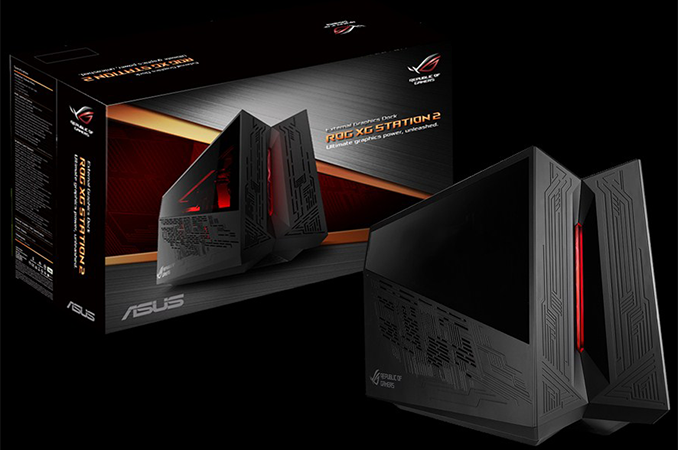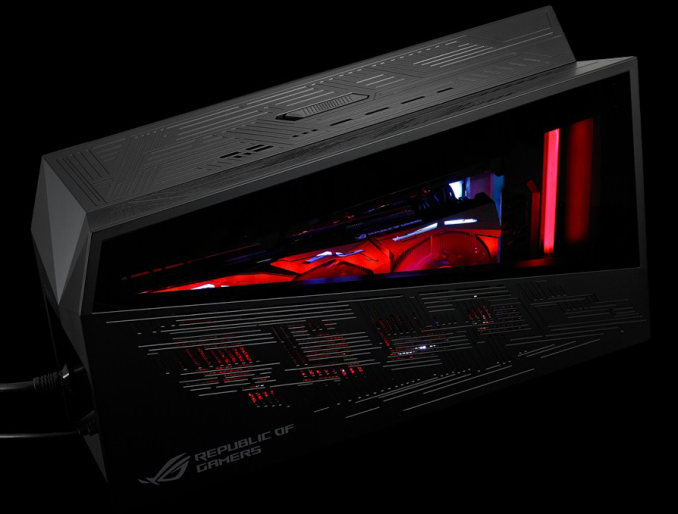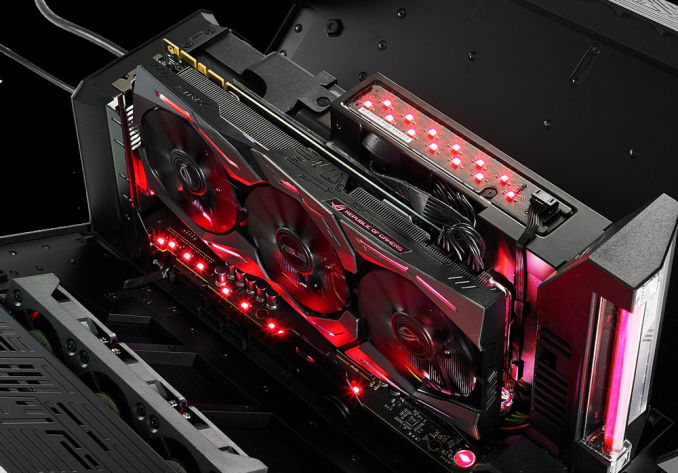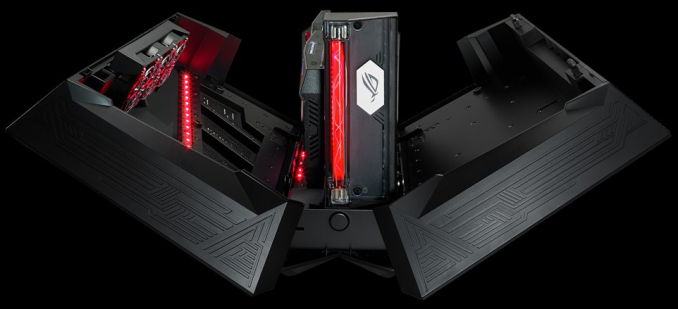ASUS ROG XG Station 2 eGFX Enclosure with Thunderbolt 3 Launched
by Anton Shilov on December 20, 2016 12:01 PM EST- Posted in
- GPUs
- Asus
- External GPU
- Thunderbolt 3
- eGFX
- XG Station

ASUS last week finally launched theROG XG Station 2 external GPU chassis, to enable Thunderbolt 3 systems to implement discrete graphics. The eGFX enclosure from ASUS integrates a 600 W PSU to ensure compatibility with power-hungry graphics adapters, and can house not only a video card but also an additional 2.5” storage device and bundles in extra USB 3.0 ports. The design of the external GPU box features signature ‘Republic of Gamers’ elements with red LEDs and Mayan-style patterning.
ASUS was among the pioneers of external graphics adapters in 2007 when it first showcased its XG Station with an integrated NVIDIA GeForce 8600 GT GPU. The dock used the Express Card interface, was not upgradeable, was only compatible with select ASUS laptops and its performance was not enough for then-popular games like Crysis (which is partly why it never took off). The company did not bury the idea of external graphics for laptops completely, and at CES 2014 the company showcased its XG Station 2 with a Thunderbolt 2 interface co-developed with SilverStone. The chassis was upgradeable and could house a variety of graphics cards, but the entire platform itself had numerous limitations when it came to bandwidth, hot-plugging, driver support and some others which is why that product was not even released. In January this year, ASUS demonstrated yet another XG Station 2, this time with a proprietary physical interface that used two USB Type-C cables (albeit with 32 Gb/s maximum bandwidth) and was to be compatible with select ASUS laptops. Around that time Intel had managed to finalize its eGFX over Thunderbolt 3 specification with some external help from AMD (see XConnect), whereas Razer showcased their compatible solution up and running (and later commercialized it). The Thunderbolt 3 graphics appeared to be so robust that ASUS decided to drop its proprietary external graphics interface and go with TB3 instead. At Computex in June, the company showcased its XG Station 2 with a Thunderbolt 3 interface, which will finally hit the market in 2017, a decade after the original XG Station (and in the third iteration of its own).
The ASUS ROG XG Station 2 looks exactly like the one demonstrated at Computex: the Mayan patterns serve like the openings to ensure proper cooling and the enclosure is equipped with multiple red LEDs controlled using the ROG AURA technology. The eGFX chassis from ASUS can accommodate a qualified double-wide PCIe x16 video card that is up to 12.2”/310 mm long. Due to TB3 bandwidth limitations, as with all TB3 eGFX enclosures, the GPUs are limited to PCIe 3.0 x4 bandwidth. The company does not specify the exact height of graphics adapters that the XG Station 2 can host, but for demonstrations it has used its ROG Strix boards with enlarged PCBs, hence it is safe to assume that there is plenty of vertical space inside the enclosure. To ensure that graphics cards receive enough power, ASUS integrated a 600 W PSU into the XG Station 2, a more powerful unit than in any other contemporary eGFX chassis. The enclosure has three 80-mm fans to pump up cool air into the box to guarantee proper cooling and enhance GPU overclocking potential for those who need it.
| ASUS ROG XG Station 2 eGFX Chassis Specifications | ||||
| Max Video Card Size | Double-Wide, 12.2" Long (312 × 170 × 44 mm) |
|||
| Max Video Card Power | 500 W (?) | |||
| Connectivity | 1 × Thunderbolt 3 (~40 Gbps via active cable) | |||
| Chassis Size | 6.22 × 17.95 × 10.94 inches (158 × 456 × 278 mm) |
|||
| Internal PSU | 600 W 80 Plus Gold | |||
| System Requirements | Thunderbolt 3 eGFX Certified PC Thunderbolt 3 w/Active Cable (included) Windows 10 |
|||
| Compatible ASUS PCs | ROG G701VI ROG GL502VM ROG GL702VM Transformer T303UA Transformer T305CA Official List |
|||
| Compatible Graphics Cads | AMD Radeon RX-series and later NVIDIA GeForce GTX 10-series and later |
|||
| Shipping Date | Early 2017 | |||
| Price | Not cheap at all | |||
UPDATE: The XG Station 2 does not feature any storage bays, contrary to what earlier documents and reports indicated.
The ROG XG Station 2 is not just an eGFX enclosure, but also rather an expansion dock for laptops that adds Gigabit Ethernet, four USB 3.0 ports as well as one 2.5” bay for a SATA hard drive or an SSD. It is noteworthy that the four USB ports are not involved in the TB3 connection and do not use PCIe bandwidth, but have to be connected using a USB 3.0 Type-B cable (which means that the XGS2 needs three cables: TB3, USB and power). From connectivity and expandability standpoint, the ASUS ROG XG Station 2 is on par with PowerColor’s Devil Box, but leaves the competitor behind it when it comes to the wattage of internal PSU.
When it comes to compatibility, the ASUS ROG XG Station 2 should work with all systems that feature Thunderbolt 3 and support of eGFX through BIOS and TB3 firmware. ASUS lists its computers that can work with its external GPU enclosure on its website, but also lists systems from other makers. Nonetheless, it should not be a problem for the ROG XG Station 2 to work with appropriate non-ASUS PCs (e.g., with Razer’s Blade Stealth) with TB3 and appropriate BIOS/FW.
| Comparison of Thunderbolt 3 eGFX Chassis | ||||||||
| ASUS ROG XG Station 2 | AKiTiO Node |
BizonTech BizonBox 3 |
PowerColor Devil Box |
Razer Core |
||||
| Chassis Dimensions | Length | 45.6 cm 17.95 in |
42.8 cm 16.85 in |
36 cm 14.17 in |
40 cm 15.748 in |
34 cm 13.38 in |
||
| Height | 27.8 cm 10.94 in |
22.7 cm 8.94 in |
20.5 cm 8.07 in |
24.2 cm 9.52 in |
21.84 cm 8.6 in |
|||
| Width | 15.8 cm 6.22 in |
14.5 cm 5.71 in |
8 cm 3.5 in |
17.2 cm 6.77 in |
10.5 cm 4.13 in |
|||
| Max Dimension of Compatible Graphics Card | Length | 31.2 cm 12.2 in |
||||||
| Height (PCB+Cables) |
over 14 cm over 5.51" |
17 cm 6.7 in |
over 14 cm over 5.51" |
14 cm 5.51 in |
15.2 cm 5.98 in |
|||
| Width | 4.4 cm 1.73 in |
5 1.96 in |
4.4 cm 1.73 in |
|||||
| Maximum GPU Power | 500 W (?) | 300 W (?) | 375 W | |||||
| PSU | Wattage | 600 W | 400 W | 200W/400W | 500 W | |||
| Form-Factor | internal proprietary | SFX | external | internal proprietary | ||||
| Cooling Fans (mm) | 3 × 80 | 120 | 2 × 60 | unknown | 3 × 80 | |||
| Connectivity | Thunderbolt | 1 × TB3 | 1 × TB3 | 2 × TB3 | 1 × TB3 | |||
| Ethernet | 1 × GbE | - | 1 × GbE | |||||
| USB | 4 × USB 3.0 1 × USB-B |
- | 4 × USB 3.0 | |||||
| SATA | - | - | 1×SATA 6Gb/s | - | ||||
| DisplayPort | - | - | 1 × DP 1.2 | - | ||||
| Availability | 1/2017 | 12/2016 | 10/2016 | 4/2016 | ||||
| Price | $? | $299 | $649 | $379 | $499 | |||
ASUS plans to start sales of the ROG XG Station 2 in early 2017. The company yet has to disclose the final pricing, but given all the advantages that the product has, we expect it will cost more than an average eGFX box.
Related Reading:
Source: ASUS



















27 Comments
View All Comments
xthetenth - Tuesday, December 20, 2016 - link
Neat that they include a big enough power supply big enough for dual GPU cards that don't get made any more without an external liquid cooler that wouldn't fit in the enclosure.damianrobertjones - Tuesday, December 20, 2016 - link
All I'd like is a basic darn box to place a gpu. It doesn't have to be fancy, cost the earth, or do strange things.STOP making things, that should be simple, far more complicated in an effort to justify raising the price to stupid levels.
A gpu ‘caddy’, which is all it pretty much is, should be no more than £199. You then have to buy the darn card so we're then heading towards £450 which is getting a bit silly really (As you also have to buy the machine to plug this into).
BrokenCrayons - Tuesday, December 20, 2016 - link
I agree. It ought to be a metal box with a graphics card, power supply, and a fan inside of it. There's far too much emphasis and expense invested in lights, windows, and other bits that simply add nothing in the realm of functionality. It's a computer part, not a statement of lifestyle.Reflex - Tuesday, December 20, 2016 - link
I would argue that USB and possibly a SATA connector make sense. These should be a docking solution as well. Having to plug in half a dozen cables to use your mobile device on a desk defeats the purpose as well.BrokenCrayons - Tuesday, December 20, 2016 - link
I don't think there's anything wrong with that idea. A lot of laptops would benefit from additional storage and leaving a keyboard and mouse connected to the GPU box would be useful too. I really think a lot of the cost in these things is sunk into unnecessary dress and lighting.Reflex - Tuesday, December 20, 2016 - link
No disagreement there. The unconventional shapes that offer little to no functionality, the style lighting, it all misses the point. This is not an attempt to turn an ultra-portable device into a desktop. It's an attempt to make it useful on a desk.MrSpadge - Wednesday, December 21, 2016 - link
I agree: a simple box which doesn't block the GPU air flow, i.e. pretty much just a metal mesh and dust filters between it and the fresh outside air. In this way no fan would be required.. although constructing such a box around a 140+ mm fan could also be tempting. Then let us attach a regular for factor PSU, so we can choose, upgrade/repair and dimension it ourselves and voila, we'd have the case with far the best price/performance ratio. It could especially appeal to people who want more GPUs in a single box for number crunching (no, I'm not talking about *coin mining).digiguy - Tuesday, December 20, 2016 - link
I wonder how much smaller (and portable) would an enclosure with a MXM Pascal GPU be... I doubt however that Nvidia would let this happen anytime soon...unrulycow - Tuesday, December 20, 2016 - link
This is super ugly and likely ridiculously expensive, but I'd like to see Anandtech review a couple of these and see the performance penalty for PCIe 3.0 x4kenansadhu - Wednesday, December 21, 2016 - link
The Razer Core got a 15% performance penalty, right (it ran at about 85% of the Card's potential). Since it is still using Thunderbolt 3, will there be any difference?